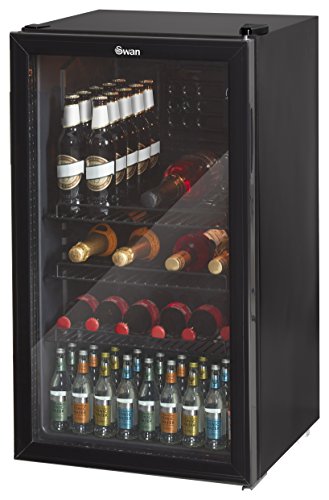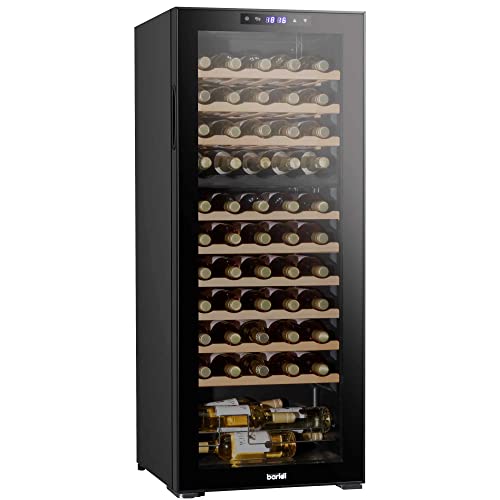You'll Never Guess This Wine Fridge Cooler's Tricks
페이지 정보

본문
 The Benefits of a Wine Fridge Cooler
The Benefits of a Wine Fridge CoolerA wine fridge cooler keeps bottles at the perfect temperature for aging and achieving their full potential. A well-designed wine refrigerator controls humidity levels in order to avoid corks drying out and oxidizing.
Opt for a wine fridge that has dual or multiple temperature zones. This is a great feature when you have different kinds of wine with different needs for storage.
Compressor-based cooling
A wine fridge cooler makes use of compressor technology to keep your most loved wines at optimal temperatures for serving or storage. This kind of cooling system can be frequently found in beverage refrigerators. It offers an even temperature throughout the refrigerator.
freestanding wine refrigerator or built-in wine refrigerators that use this cooling technology can be affixed to your bar, kitchen wine fridge or wine cellar closet. They can be mounted under counters or recessed, and in a lot of cases come with front-facing ventilation, so that they can blend seamlessly into your other kitchen appliances.
Wine refrigerators that make use of this cooling technology don't just maintain the correct temperature but also offer other functions important for storing wines. They can, for example come with an humidification control system that controls the air inside the refrigerator and adjusts water flow in order to ensure that wine bottles are adequately moistened. This stops oxidation, which could affect the flavor of the wine.
Some wine coolers come with dual or even triple temperature zones, which means you can store different kinds of wine at the optimal temperature. This is an excellent option for those who serve both white and red wines or who want their wine collection divided into different storage categories.
Some wine refrigerators use this type of cooling to create an UV-resistant door that shields the wine from harmful ultraviolet radiation.
In addition to their ability to cool wine at the right temperature, wine refrigerators with this technology are typically quiet and produce no vibrations. They do not utilize liquid refrigeration and therefore do have moving parts which vibrate or cycle while running. This reduces the vibrations that can cause hardware to break and other issues in the wine fridge cooler. It also helps to reduce noise from the cooling system and keep your wine chiller fridge tasting its best.
Thermoelectric Cooling
Thermoelectric coolers are a distinct technology than compressor-based units. Instead of using refrigerants, thermoelectric coolers rely on the Peltier effect to keep wine bottles cool. This occurs when an electrical current is passed through two pieces of metal that are joined and causes one side to become warmer while the other becomes colder. This temperature difference allows the cooler to keep the cabinet cool.
In most cases, the cooler will use an air source to distribute cold air across the interior of the cabinet. This is usually an aluminum piece that has been electrolyzed to increase its surface area and assist in dispersing heat. Fans are placed at either end of the heat sink in order to circulate air and maintain a constant temperature.
This technology is eco-friendly. Thermoelectric coolers are environmentally friendly because they don't use refrigerants. They are also cheaper to run and consume less energy than compressor-based coolers.
However it is important to know that thermoelectric wine coolers may not be as efficient in keeping wine bottles at an optimal temperature as compressor units. They are not able to reach the required temperature. They also require more maintenance because they are always running.
Thermoelectric wine fridges are quiet, and they are eco-friendly. This makes them an excellent choice for those who reside in homes or restaurants where it is crucial to preserve the atmosphere of the space. They are also great for living rooms where people like to entertain guests or sip a glass of wine on their own. They can be put anywhere in the home or restaurant and without causing any disturbance. They don't use any motors or compressors that are noisy.
Humidity Control
Wine is sensitive to the environment and requires precise conditions to age correctly. Temperature and humidity play crucial parts in the process, ensuring the integrity of the cork and preserving its quality over time. A wine fridge keeps an ideal temperature range and controls humidity to ensure the perfect maturation process.
The ideal humidity for wine storage ranges between 50 and 70. If humidity levels decrease the wine may lose its taste and begin to develop an oxidation. Mold and mildew can also thrive in excessive humidity, which can damage labels or alter the quality of cork. Wine fridges create an environment that discourages the development of mildew and mold which protects the appearance and flavor of wine.
Many wine refrigerators come with humidity control systems that regulate and maintain the appropriate levels of humidity. These systems incorporate a built-in hygrometer to monitor the air temperature in the wine cellar and automatically adjusts humidity settings to maintain it within the desired range.
Additionally, some wine refrigerators are equipped with internal fans that aid in the circulation of air and help prevent pockets of warm or humid air from creating. This ensures consistent conditions throughout the wine storage space and reduces energy consumption by minimizing fluctuations in the temperature of the fridge's operation.
The majority of wine refrigerators have doors with solid or double-paned glass that provides insulation and protection against harmful UV rays, which can cause degradation of wine compounds and alter their flavors. Some are also equipped with vibration reduction mechanisms to reduce disturbances that can disturb sediment in older bottles and disrupt the aging process.
If your wine refrigerator has been operating in inadequate conditions for a prolonged period of time, you might have to add additional moisture. In the short term, you can use moisture absorbers and air dehumidifiers made of crystals or mineral salts to absorb water vapour in the air. These devices should be emptied and replaced on a regular basis. If you want a permanent solution, you can install an active humidification system that incorporates water atomizers and a water tank.
Capacity of Storage
If you regularly enjoy wine fridge for kitchen and want to have a few bottles on hand for unexpected or spontaneous events, then having a reliable wine fridge is a must. These appliances recreate the ideal conditions of natural cellars and caves so your wines can be able to develop their best flavors over time.
Wine is a complex blend of substances that interact to create distinct aromas and flavors. The proper storage conditions will preserve these properties and prevent premature aging, which can deprive the wine of its essence. In a conventional refrigerator, fluctuations in temperature can damage these molecules, causing the flavors to diminish. In a wine fridge, humidity control and constant temperatures will prevent these issues.
In addition to keeping ideal temperatures, wine refrigerators regulate humidity levels to keep corks from drying out and leakage. If the wine bottle is stored in a humid environment it's possible that labels will fall off. The wine may also lose its taste. Wine refrigerators maintain a relative humidity between 55% and 75%, protecting the integrity of the wine bottle and preventing oxidation.
These cooling systems are often equipped with internal fans that ensure an even flow of air throughout the cabinet. This helps eliminate pockets of warm or humid air and keeps the entire collection at the same temperature. Many units also include racks and shelves designed to gently and securely hold bottles. This helps to protect the bottles from damage and helps you to arrange your collection in a way that is efficient.
Some wine refrigerators feature dual temperature zones, which are helpful for storing different types of wine at the optimal temperatures. Other features that are common to these devices include UV-resistant doors and LED lighting. These features stop harmful sunlight from reaching your wines, while keeping them easy to find. Certain wine fridges also come with carbon filters that help to reduce the smell of the air which may get into the corks, affecting the flavor of the wines.
Consider the size of your wine collection as well as the space you have to store it when you shop for refrigerators. Wine coolers are available in many sizes and shapes, and can be mounted under cabinets or counters. Some have front venting which allows them to be placed in a smaller space. Some wine fridges also have adjustable shelves, allowing you to accommodate oddly-shaped bottles.

- 이전글Popular argumentative essay ghostwriter site uk 24.11.09
- 다음글Hyper-reflexia, cha 24.11.09
댓글목록
등록된 댓글이 없습니다.
